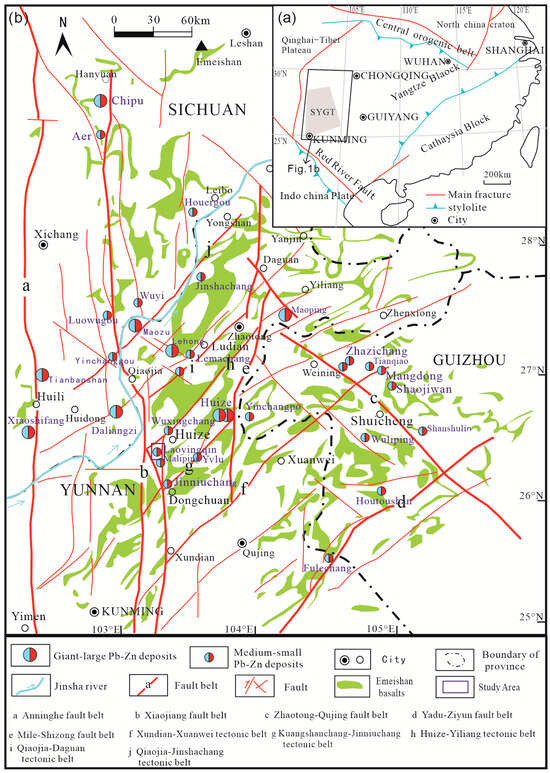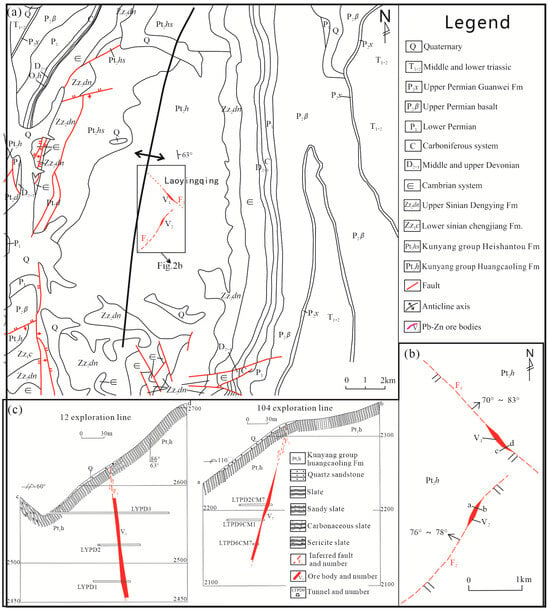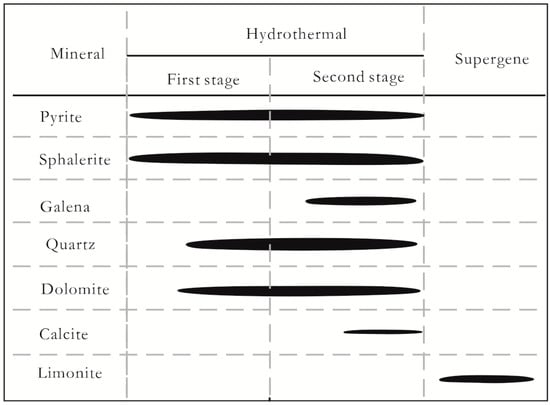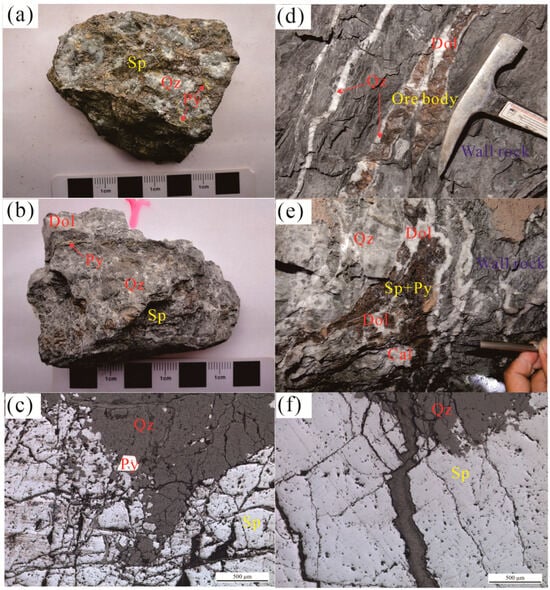You're using an outdated browser. Please upgrade to a modern browser for the best experience.

Submitted Successfully!
Thank you for your contribution! You can also upload a video entry or images related to this topic.
For video creation, please contact our Academic Video Service.
| Version | Summary | Created by | Modification | Content Size | Created at | Operation |
|---|---|---|---|---|---|---|
| 1 | jinhang Lu | -- | 1232 | 2024-01-12 05:13:40 | | | |
| 2 | Jason Zhu | Meta information modification | 1232 | 2024-01-12 07:54:03 | | |
Video Upload Options
We provide professional Academic Video Service to translate complex research into visually appealing presentations. Would you like to try it?
Cite
If you have any further questions, please contact Encyclopedia Editorial Office.
Lu, J.; Gong, H.; Wu, P.; Zhang, C. Laoyingqing Zinc Deposit in Northeastern Yunnan. Encyclopedia. Available online: https://encyclopedia.pub/entry/53771 (accessed on 25 December 2025).
Lu J, Gong H, Wu P, Zhang C. Laoyingqing Zinc Deposit in Northeastern Yunnan. Encyclopedia. Available at: https://encyclopedia.pub/entry/53771. Accessed December 25, 2025.
Lu, Jinhang, Hongsheng Gong, Peng Wu, Changqing Zhang. "Laoyingqing Zinc Deposit in Northeastern Yunnan" Encyclopedia, https://encyclopedia.pub/entry/53771 (accessed December 25, 2025).
Lu, J., Gong, H., Wu, P., & Zhang, C. (2024, January 12). Laoyingqing Zinc Deposit in Northeastern Yunnan. In Encyclopedia. https://encyclopedia.pub/entry/53771
Lu, Jinhang, et al. "Laoyingqing Zinc Deposit in Northeastern Yunnan." Encyclopedia. Web. 12 January, 2024.
Copy Citation
The Laoyingqing zinc deposit is located in the Pb-Zn deposit concentration district in northeastern Yunnan, with a geotectonic location on the southwestern edge of the Yangtze block. This deposit occurs in the interlayer fracture zone of the Huangcaoling Formation slate in the Middle Proterozoic Kunyang Group.
fluid inclusions
H–O isotope
trace elements
source of ore-forming materials
Laoyingqing zinc deposit
1. Introduction
Different scholars have proposed different viewpoints on the genesis of Pb-Zn deposits in the SYGT. The viewpoints of most scholars are that they are the Mississippi Valley type (MVT) and the strata-bound type dominated by sedimentation [1][2][3]. By contrast, Han Runsheng et al. [4] proposed they are the Huize type (HZT).
The Laoyingqing zinc deposit is about 19 km in horizontal distance from Huize County, Yunnan Province, with a geotectonic location on the southwestern edge of the Yangtze block. Previous research on this deposit mainly includes the following: (1) Yang Xiaoxia [5] and Bian Shantao et al. [6] believed that the ore body is controlled by fault fracture zones, and the genesis of this deposit is a fracture-filling vein-type Pb-Zn deposit, whereas (2) Gong et al. [7] studied the composition of Pb and Sr isotopes and believed that the ore-forming metals mainly came from surrounding rocks (Kunyang Group).
The Laoyingqing zinc deposit is hosted in the slate of the Huangcaoling Formation of the Kunyang Group, and zinc is significantly enriched compared to lead in this deposit. Being unlike other common Pb-Zn deposits hosted in Sinian and Carboniferous carbonate rocks in northeastern Yunnan, the genesis of this deposit and its similarities to and differences from other Pb-Zn deposits hosted in carbonate rocks in the Sichuan–Yunnan–Guizhou Pb-Zn metallogenic triangle area (SYGT) need further research.
2. Metallogenic Geological Background
The SYGT is located on the western edge of the Yangtze platform (Figure 1a), with its layers mainly including basement and sedimentary cover. The Yangtze platform has a “double-layered basement” structure, and the crystalline basement is composed of the Archean Kangding Group. The folded basement is composed of the Middle Proterozoic Yanbian Group, the Huili Group, and the Kunyang Group [8]. The region is widely developed, with north–south-, northeast-, and northwest-trending faults and folds (Figure 1b). The Pb-Zn deposit concentration district in northeastern Yunnan is distributed within the “triangle area” enclosed by three deep and large faults: the north–south Xiaojiang Fault, the northwest Yadu–Ziyun Fault, and the northeast Mile–Shizong Fault. Almost all Pb-Zn deposits in the area are distributed along deep and large fault zones and secondary structures, with obvious structural ore-control effects.

Figure 1. Structural sketch of Southwest China (a) and distribution map of main faults and mineral deposits in the SYGT (b).
The exposed strata in the mining area of the Laoyingqing zinc deposit include the Middle Proterozoic Kunyang Group Huangcaoling Formation (Pt2h), the Heishantou Formation (Pt2hs), the Sinian Dengying Formation (Z2dn), and the Quaternary System (Q). Among them, the lower section of the Middle Proterozoic Kunyang Group Huangcaoling Formation (Pt2h1) is the main ore-bearing layer, and the lithology of this section is thin-to-medium- layered slate with a small amount of limestone and dolomite. There is no exposed magmatic rock in or around the mining area. The main ore-controlling faults in the mining area are F1 and F2, among which F1 is a reverse fault with a fault occurrence of 60 ° ∠ 86 ° and a fault width of 1.6–16 m; F2 is a nearly vertical reverse fault with a fault occurrence of 115 ° ∠ 86 ° and a fault width of 1.5–7.5 m. Similar to F1, F2 is filled with breccia and fragmented slates containing sphalerite. The main wall rock alterations include silicification and carbonatization, which are distributed in the fault fracture zones and the surrounding rocks on the side of the ore bodies.
The V1 and V2 ore bodies in the mining area are strictly controlled by the Wuxing anticline and occur in the F1 and F2 fracture zones, respectively (Figure 2). The occurrence of these ore bodies is basically consistent with the faults. The V1 and V2 ore bodies belong to steeply inclined ore bodies. The controlled ore bodies are 302–371 m long and 3.10–3.56 m thick. The morphology of the ore bodies is irregular and locally swollen. The average thickness of the V1 ore body in a single engineering project is 3.56 m, with an average grade of 4.90%. The average thickness of the V2 ore body in a single engineering project is 3.10 m, with an average grade of 5.36%. In the V1 and V2 zinc ore bodies, it is estimated that the 332 and 333 types of zinc resources are 657,500 tons, the total amount of zinc metals is 32,992.55 tons, and the average grade of Zn is 5.02%. Among them, the amount of zinc resources of the 332 type is 328,600 tons, the amount of zinc metals is 15,916.40 tons, and the average grade of Zn is 4.84%; the amount of zinc resources of the 333 type is 328,900 tons, the amount of zinc metals is 17,076.15 tons, and the average grade of Zn is 5.19%.

Figure 2. Geological map of the Laoyingqing zinc deposit (a); geological sketch of the deposit (b); and geological profile of Exploration Line 12 in Laoyingqing Ore Block and geological profile of Exploration Line 104 in Laolongtian Ore Block (c).
The metal minerals in the ores of this deposit are mainly waxy-yellow and iron-black sphalerite, with low contents of galena, chalcopyrite, pyrite, and limonite. The metal minerals do not reach industrial grade, except for sphalerite. The gangue minerals mainly include calcite and quartz, followed by mica, dolomite, chlorite, and a small amount of feldspar. The ores have an idiomorphic or semi-idiomorphic granular texture, including texture with a block-like, disseminated, or fine vein-like structure. The natural type of the ores is mainly sulfide ore, while the industrial type is mainly sphalerite–quartz vein-like structural breccia, accounting for about 87.3%. The secondary type is sphalerite–quartz vein-like slate, accounting for about 12.7%.
Based on the typical ore samples and microscopic observations, the deposit had undergone a hydrothermal mineralization period and a supergene period, with two main mineral associations formed during the hydrothermal mineralization period (Figure 3).

Figure 3. Mineral generation sequence of Laoyingqing zinc deposit.
Sphalerite–quartz–carbonate combination: This combination is the main mineral combination of zinc ore in the mining area and is commonly seen. The main metal sulfide is sphalerite; the main gangue mineral is quartz, followed by calcite. This combination often exhibits strong zinc mineralization and a high zinc grade. Pyrite, quartz, and carbonate minerals such as dolomite formed in the earlier stage were metasomatized by sphalerite (Figure 4a–c). Based on the sequence of mineral formation shown in Figure 3, this mineral combination formed earlier and can be designated as the first stage of mineralization.

Figure 4. Typical ore texture and structure photos of Laoyingqing zinc deposit: (a) brecciated ore; (b) block ore; (c) pyrite and sphalerite are metasomatized by quartz; (d) veined ore body; (e) veined ore body; and (f) sphalerite is metasomatized by quartz. Gn: galena; Py: pyrite; Sp: sphalerite; Qz: quartz; Dol: dolomite; Cal: calcite.
Sphalerite–galena–pyrite–quartz–carbonate combination: This combination is a secondary mineral combination in the mining area. The main metal sulfide is sphalerite, followed by galena and pyrite; the main gangue mineral is quartz, followed by calcite. Zinc mineralization is weak, and the zinc grade is low. Sphalerite was metasomatized by quartz and pyrite, and formed an “island” and “harbor” structure (Figure 4d–f). Based on the sequence of mineral formation shown in Figure 3, this mineral combination formed relatively later and can be designated as the second stage of mineralization.
References
- Zhou, C.X.; Wei, S.S.; Guo, J.Y.; Li, C.Y. The source of metals in the Qilinchang Zn-Pb deposit, northeastern Yunnan, China: Pb-Sr isotope constrains. Econ. Geol. 2001, 96, 583–598.
- Wang, J.Z.; Li, C.Y.; Li, Z.Q.; Li, B.H.; Liu, W.Z. The Comparison of Mississippi Valley-Type Pb-Zn Deposits in Southwest of China and in Mid-Continent of United States. Bull. Mineral. Petrol. Geochem. 2002, 21, 127–132.
- Zang, C.Q.; Mao, J.W.; Wu, S.P.; Li, H.M.; Liu, F.; Guo, J.K.; Gao, D.R. Distribution, characteristics, and genesis of Mississippi Valley-Type lead-zinc deposits in Sichuan-Yunnan-Guizhou area. Miner. Depos. 2005, 24, 336–348.
- Han, R.S.; Hu, Y.Z.; Wang, X.K.; Hou, B.H.; Huang, Z.L.; Chen, J.; Wang, F.; Wu, P.; Li, B.; Wang, H.J.; et al. Deposit model of germanium rich silver lead-zinc polymetallic ore cluster in northeastern Yunnan. J. Geol. 2012, 86, 280–294.
- Yang, X.X. Geological Characteristics and Prospecting Prospects of the Laoyingqing Zinc Deposit in Huize County, Yunnan. Yunnan Geol. 2015, 34, 86–89.
- Bian, S.T.; Zhu, H.G.; Yang, Y.Z. New horizons of zinc deposits in the Huangcaoling Formation of the Kunyang Group in Laoyingqing, Huize, Yunnan. Yunnan Geol. 2012, 30, 195–199.
- Gong, H.S.; Han, R.S.; Wu, P.; Chen, G.; Li, L.J. Constraints of S Pb Sr isotope compositions and Rb Sr isotopic age on the origin of the Laoyingqing noncarbonate-hosted Pb Zn deposit in the Kunyang Group, SW China. Geofluids 2021, 1–21.
- Zhang, C.Q. Metallogenic model of Mississippi type (MVT) Pb-Zn deposits in the border area of Sichuan-Yunnan-Guizhou, China. Ph.D. Thesis, Chinese Academy of Geological Sciences, Beijing, China, 2008.
More
Information
Subjects:
Geochemistry & Geophysics
Contributors
MDPI registered users' name will be linked to their SciProfiles pages. To register with us, please refer to https://encyclopedia.pub/register
:
View Times:
502
Revisions:
2 times
(View History)
Update Date:
12 Jan 2024
Notice
You are not a member of the advisory board for this topic. If you want to update advisory board member profile, please contact office@encyclopedia.pub.
OK
Confirm
Only members of the Encyclopedia advisory board for this topic are allowed to note entries. Would you like to become an advisory board member of the Encyclopedia?
Yes
No
${ textCharacter }/${ maxCharacter }
Submit
Cancel
Back
Comments
${ item }
|
More
No more~
There is no comment~
${ textCharacter }/${ maxCharacter }
Submit
Cancel
${ selectedItem.replyTextCharacter }/${ selectedItem.replyMaxCharacter }
Submit
Cancel
Confirm
Are you sure to Delete?
Yes
No




